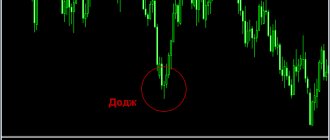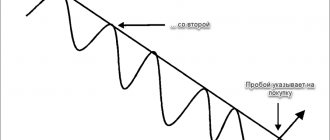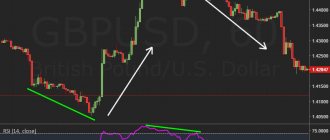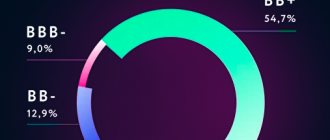Let's consider forward motion. When a body moves translationally, its coordinates change.
Rectilinear motion is when a body moves in a straight line. The straight line along which the body moves will be called the Ox axis.
We will consider separately:
- movement without acceleration (uniform), and
- movement with acceleration (uneven).
1). Uniform motion - the speed of the body remains the same (i.e. does not change). With such movement there is no acceleration: \(\vec{a} =0\).
2). Uneven movement - the speed changes and acceleration appears.
Let there be acceleration and it does not change: \(\vec{a} =const\). Such uneven movement is called uniformly variable. To clarify whether the speed is increasing or decreasing, instead of the word “equally variable” they say:
- Uniformly accelerated motion - the speed of the body increases.
- Equally slow motion - speed decreases.
Note: When the speed changes, there is always an acceleration!
We will depict the movement graphically using two perpendicular axes.
On the graphs we will plot:
- horizontally - time in seconds.
- vertically - body coordinates, or projections of velocity and acceleration.
For each type of movement we get three graphs. We will call the graphs like this:
- x(t) – dependence of the coordinate on time;
- v(t) – dependence of the velocity projection on time;
- a(t) – dependence of the acceleration projection on time.
Read first what the projection of a vector onto an axis is, this will help you better understand the material.
Bars
This is a well-known chart for displaying prices on the stock exchange. The bar is built like this:
- the vertical line shows the price change for the selected period of time: if the chart is for 1 hour, then one bar will be equal to the price movements during this time,
- the horizontal line on the left is the opening price,
- horizontal line on the right - closing,
- upper limit - maximum for the selected period,
- the lower limit is, accordingly, the minimum.
The distance from the line to the end of the bar is called the upper or lower shadow, depending on the direction.
The entire segment, that is, the distance from the lower to the upper border, is called the spread. Depending on the price movement, bars are classified as follows:
up-bar – when the closing price of this bar is higher than that of the previous one,
down bar (down-bar) – the closing price is lower than the previous bar.
The bars are arranged in a sequential line; they are convenient because information about the price is compactly collected in one icon.
General scheme for constructing a graph of a function using geometric transformations
Consider a function that is “based” on some function. For many readers, the algorithm for constructing a graph is already clear:
– at the first step we perform transformations related to the ARGUMENT of the function (see the first two paragraphs), as a result of which we obtain a graph of the function;
– in the second step, we carry out the transformations just considered related to the FUNCTION itself, and get a graph.
Let's finish the longest construction of this lesson:
Example 19 (ending of Example 10)
Graph the function
In example No. 10, we completed plotting, that is, we completely understood the function argument. Now all that remains is to complete the final steps.
Function graph:
4) display symmetrically about the axis: ; 5) move along the axis 3 units up: :
In practice, fortunately, the constructions are almost always shorter, for example:
– we shift the cubic parabola along the axis by 5 units to the right and compress it along the axis by 3 times.
– display the exponential graph symmetrically with respect to the ordinate axis, then symmetrically with respect to the abscissa axis.
– we shift the function graph to the left by 5 units, then up by 1 unit.
Etc. Some geometric transformations can be swapped, but this is not always possible! Therefore, it is better for “dummies” to adhere to the algorithm outlined at the beginning of the paragraph.
All the material in the article, which is largely of a reference nature, will be required to complete drawings in other tasks, but from time to time in practice the task in question occurs separately, and, sometimes, in a “raw” form:
Example 20
Construct a graph of a function using transformations of graphs of elementary functions
I discussed the technique for quickly constructing a parabola in the first lesson about graphs of functions , but here, according to the condition, it is necessary to apply a very specific method.
At the first step, we represent the function in the form . To do this, we use the so-called method of selecting a complete square. I advise you not to neglect the task, since the standard technique will be required in the future, for example, when finding integrals of certain fractions .
The idea is to artificially transform the SO function to take advantage of one of the abbreviated multiplication formulas or .
Let's start the transformation. We take the coefficient out of the bracket: Obviously, the expression will be reduced to the formula . In parentheses we construct: Thus, . Now let’s organize , for this we add and subtract in brackets: We take the last term out of brackets: We use the formula and sum the last two terms:
For testing purposes, it is advisable to open the parentheses and make sure that you get the original function:
Let's build a graph. Parabola:
1) Shift along the axis to the left: (blue color); 2) Extend it 2 times along the axis: (raspberry color); 3) Move upward along the axis: (red):
Let's look at another typical trick:
Example 21
Construct a graph of a function using transformations of graphs of elementary functions.
First, let's reduce the function to the form . I will comment out all the actions:
(1) In the denominator we take –1 out of brackets. This is necessary so that the function argument can be presented in the “usual” order. (2) We put the minus denominator in front of the fraction. Let's carry out an artificial transformation in the numerator - add and subtract one. This is necessary for term-by-term division in the next step. (3) Divide the numerator by the denominator term by term. Take note of the technique discussed; it is used when integrating fractions . (4) Open the brackets.
Let's do the construction. Hyperbola graph (black):
1) Shift to the right by 1 unit: (blue color); 2) Display symmetrically relative to the x-axis: (raspberry color); 3) Shift along the axis one unit down: (red):
Let's move on to the final part of the lesson, in which we will talk about the module. I wanted to make it a separate small page or pdf, but then I changed my mind, why bother with trifles. Although this article is far from a record number of letters, a significant part of the volume is occupied by drawings.
Japanese candles
This is probably the most popular quote chart. The main volume is called the body of the candle, and the lines behind the rectangle are the wick or shadow. When the opening and closing prices coincide, the body of the candle is not displayed, or will be displayed as a very narrow strip.
The most commonly used combination is red (when the closing price is lower than the opening) and green (the price is rising). But it can also be black/white, contrasting to the background/background color.
There is also a variation of the Empty Candles chart. When the closing price is higher, the body is not painted over.
Using this simple indicator, they analyze the chart and make assumptions about how the price will move. We will talk about candlestick patterns in trading separately in the following articles.
Sometimes there is debate about which is better: bars or candles. But in reality, the bar displays the same thing in a slightly different way, it’s just that the body is not drawn. You may like this from an aesthetic point of view: some want a lighter graph, others a more massive one. Also, candles came from Japan, and bars were invented in the West. The only thing is that when switching from bars to candles and vice versa, the patterns will be displayed differently (and they have different names, for example, engulfing pattern = outside bar).
How to change graph axes in Excel
Good afternoon.
When creating graphs based on Excel tables, the program automatically calculates the values and builds a graph based on these calculations, but there is a possibility that the automatically created graph will be inconvenient or unpresentable. To correct its appearance, you simply need to swap the axes: set the X axis vertically and the Y horizontally.
How to build a graph and change axes?
For example, let's take a table with a sales schedule for a pet store. The names of animals are written vertically, months of sales horizontally.
Let's build a graph. To do this, select the table with the left mouse button. In the insert tab, select “insert graph”. After clicking on the “Graph” icon, a window with a graph will appear on the sheet.
Heiken Ashi
Heiken Ashi translates from Japanese as “balance of emptiness.” Sometimes shortened to NA. It looks like a candlestick chart, if you don’t know the features of this young indicator.
Traditionally, a candlestick and a bar display price data (based on the totality of traders’ transactions) for a certain period of time.
HAs are built on the basis of candles, but differently. The opening price is taken from the previous candle, more precisely from the sum of the open and close divided by two.
The closing price is obtained from the average of the open, close, high and low of the Japanese candlestick, divided by 4 (because there are four elements).
The maximum ON candles is also unusual. It is calculated from the high of the Japanese candlestick and the opening/closing price. And back for the minimum.
This method of displaying a graph allows you to build a smoother line and avoid unnecessary noise. Since the elements are related to the previous and subsequent ones, it is considered a more visual tool.
The same patterns, trends, etc. apply to Heiken Ashi as to regular candles. The combination of two charts is used for trading on pullbacks. It displays less volatility, so it often helps young traders not to close/open a position before the right time.
How to display projections of points onto coordinate axes in an Excel chart
Greetings to all readers of my blog. In this article I will tell you how to display projections of points on coordinate axes on an Excel chart. To make it clear what we are talking about, let's look at the original example.
So, on the Excel worksheet in cells A1:B9 the initial data for the X values and the corresponding Y values are shown. A scatter plot is constructed nearby, as shown in the figure:
*Each picture can be enlarged by left-clicking on it
This diagram has horizontal and vertical grid lines in its plotting area. But, please note that the points marked with square markers on the graph do not coincide with these grid lines.
On the other hand, if we remove these grid lines and instead add dashed line projections to the graph, then our chart will look like this:
What is the difference between the first and second diagram? Now from each point on the graph to the horizontal and vertical axis to the intersection there is a dotted line. This is what we need to get.
To see the entire process of constructing such a diagram from A to Z, watch our video tutorial or you can use the step-by-step recommendations below.
Select the table with the source data, cells A1:B9, go to the “Insert” tab and build a scatter plot with smooth curves and markers.
Then, making sure that the constructed scatter plot is selected, go to the “Layout” tab and in the “Error bars” drop-down list, select the “Error bars with standard errors” item. Now our diagram looks like this:
As can be seen from the figure, the error bars serve to ensure that for each point on the graph it is possible to indicate the magnitude of the error, that is, the possible displacement along the vertical and horizontal axes.
And we use them for our own purposes! The basic idea of this method is that the vertical error bars should start at the horizontal axis and go up or down to the corresponding points on the graph. Accordingly, the horizontal error bars should start at the vertical axis and go to the right or left until they intersect with a point on the graph. How to do it?
Let's start with the vertical error bars. Left-click on one of them. This will highlight all the vertical strips. Next, right-click on them and select “Format error bars” from the context menu. The corresponding dialog box opens on the screen:
The Vertical Error Bars tab is open by default. In the “Error value” section, set the switch to the “Custom” position and press the “Specify value” button. In the window that opens, in the “Positive error value” field, put 0, and in the “Negative error value” field, set the range of cells B2:B9 and click the “OK” button.
Immediately in the “Format Error Bars” window, switch to the “Line Type” tab and select the desired stroke type for the vertical error bars. After completing all the settings, close this window.
The horizontal error bars are adjusted in the same way. Select them with the left mouse button, right-click on the selected objects and select “Format error bars” from the context menu.
Having selected a custom error value, click the “Specify value” button and in the “Positive error value” field we still set 0, and in the “Negative error value” field – the range of cells A2:A9.
Also, don't forget to change the stroke type for the horizontal error bars.
As previously reported on our website, if an Excel chart displays the dynamics of several indicators at the same time, you can add another vertical axis to the chart.
Source: https://videolections.blogspot.com/2018/09/excel_9.html
Line
The line represents the connected segments between closing prices.
Lines are used in some trading strategies based on mathematics: in this case, there is no need to clutter the chart with unnecessary information. It is also convenient to display the general price behavior with a line, which is more used in the media, reports, etc. But the lines themselves are not informative enough.
Spaghetti Charts
Unfortunately, it's not really about food. The spaghetti chart is a very unusual type of chart that is only gaining popularity. You can't explain this without a visual clue.
Hurricane Irma's path. Source xpress.co.uk
Analysis of life expectancy and income levels in 207 countries. Source SAS
In addition to meteorology, these diagrams are suitable for visualizing relationships , which is especially useful in legal and judicial matters.
Baseline
The "baseline" chart style features a single line in the middle, which is neutral (but can also be customized). From there, the chart moves up if the price rises, and down if the quotes fall.
It helps analyze the amplitude of fluctuations and volatility. Timeframes can also be customized, as can starting points (closing only, average and other options).
Geographic Charts
Source DataViz
Geographic charts are specifically designed for analyzing geographic information, representing spatial relationships, and regional data. Use them when you need to graphically depict a global clientele, a company's expansion plan, or a production diversification plan. These charts will show which geographic areas are growing and which need more attention. They also help make decisions, such as where to invest or which countries are better to live in.
Renko
Renko is another Japanese way of displaying prices. When constructing it, time and trading volume are not taken into account.
A graph is like bricks (its name falsely translates as “brick”):
- the closing price is compared with the closing, high or low of the previous element,
- if the price is higher than the previous indicator and this difference is greater than the size of one renko, then a white/green brick will be built in a new column,
- if the price falls and the difference is greater than the size of a brick, a black or red renko is drawn.
And if the price changes more than the renko, the corresponding number of these full pieces is drawn (one brick after another in a row). The length is set by the trader. It is determined, as a rule, based on market volatility, but it is difficult to give exact figures.
And if the price doesn't change enough, the chart won't update.
For example, the previous maximum is 800. The new price is 900. And the step is set to 150. In this case, no brick will be added. If the price rises to 1200, then two renko will appear.
Renko is used to determine support and resistance and track the trend, because it clears the chart of small movements.
Economic calendar
The easiest way to determine where the chart will go is to study the economic calendar. Major economic news remains one of the main factors that influence the value of an asset. With the help of a special calendar, investors always know exactly at what time and on what day important data that can affect the market will be published.
Increase
To trade, it is enough to open the trading terminal at a predetermined moment and launch the chart of the asset on which the news is expected to be released. When economic information is published, trading participants will react to it immediately. On the chart you can see a quick drop or a sharp increase in value. The direction depends on how the majority of traders perceived the event.
Line break
The linear breakout chart also does not take into account time and volume. It is built based on closing prices, displaying them with rectangular lines.
To construct a chart, a base line is selected - a price level, a reference point.
All constructions will take this line into account: new prices will be above or below it, therefore green or red. The next bar is built taking into account the previous one, and so on sequentially until a linear breakout occurs.
The chart is used to track when a trend will change direction, as well as in classic patterns and to determine support/resistance:
Line break charts are constructed from a series of bars. The key to use is the user-specified Number of Rows parameter. The most common is 3. If the current price is higher, it is the upper line, and if lower, it is the lower line. If the current closing price is the same or the movement in the opposite direction is not large enough, then a new line is not drawn.
Indicators
It is hardly possible to imagine a technical analysis of a digital options chart without indicators. The main task of the indicator is to determine the current trend. Some tools perform this operation better, while others perform worse.
Whatever the toolkit is chosen, there is no need to think that it will demonstrate the future. All indicators are lagging. Therefore, there is no way to read option charts with 100 percent accuracy.
Among trend tools, the most common indicators are the moving average line and Bollinger Bands. Oscillators include Stochastic and RSI.
There are several dozen indicators on the live chart. An investor should conduct tests and choose the best one for himself.
Kagi
Kagi is a type of chart consisting of vertical lines (green for rising and red for falling, or a combination of thin and bold) and small horizontal lines connecting them.
The word kagi comes from the Japanese art of printing on wooden blocks. "Kagi" is an L-shaped guide that is used to align the paper for printing.
Like Renko, Kagi do not rely on time, but only take into account price action. Starting from the first point (usually the first closing price), Up lines (also called the yang line) are formed during uptrends, and Down lines (yin lines) are displayed when the trend is downward.
As long as prices continue to move in the current direction, the line continues. After the price has completely reversed (the amount required for the reversal is set by the trader), a horizontal line is drawn, and then the line goes in the opposite direction.
There are five different types of lines that can be drawn inside a Kagi chart:
Up Lines (Yan lines) during an uptrend,
Down Lines (Yin lines) during a downtrend,
Projected lines up and down. During the day, a potential line is formed based on the current price (even before the actual closing price),
Horizontal lines that are drawn when the line changes direction. When yang changes to yin, the horizontal line is called the shoulder, and the opposite is called the waist.
Choosing a timeframe
The choice of trading strategy largely depends on the time interval during which the candle is formed. This is the timeframe.
Increase
There are significantly more timeframes in live charts than in built-in brokerage terminals. You can analyze quotes with a period from 1 minute to 1 month.
Starting from the 1D timeframe and higher, you can clearly understand where the price will go in the long term. When trading short-term, investors often analyze charts on a 1-minute or 15-minute time frame. For medium-term trading, an interval of 15 minutes is used.
Tic Tac Toe
This chart is based on the closing price for a specified period. If the price rises, an X is placed in the cell; if it falls, a 0 is placed. A new mark appears if the price has changed sufficiently: the change coefficient is set by the trader.
Used to make a long-term forecast. But since time is not used, these bars can be deceiving: you can overtake in hours what took months to form in a sideways trend.
The patterns used for this chart are: rectangle, breakout, head and shoulders, triple and double top and others.
Bubble Charts
Source Data-Daily
Not a very serious name, but that's not the point. The scope of application of such diagrams in data presentation and analysis is enormous. Technically speaking, a bubble chart is useful for visualizing the analysis of interactions and distributions . Simply put, information is presented in three dimensions or planes. Let's say you have three types of data: the total number of products, the number of each product sold, and the sales revenue of each product. If you want to see the relationship of this data on one graph, then a bubble chart is for you.
Ray diagram (Sunburts)
Source Baguzin “New charts in Excel”
Fans of online shopping, this information is for you. Your behavior on the site and which pages you visit are recorded in history, and store administrators can easily present this information in the form of a ray diagram to understand where the main traffic on the site goes and which pages are visited the least. These charts are ideal for presenting hierarchical data.









